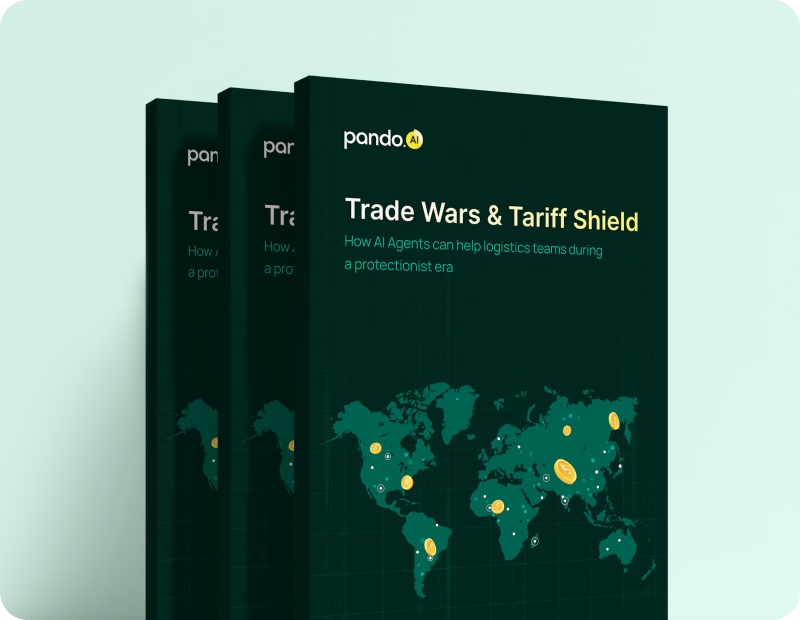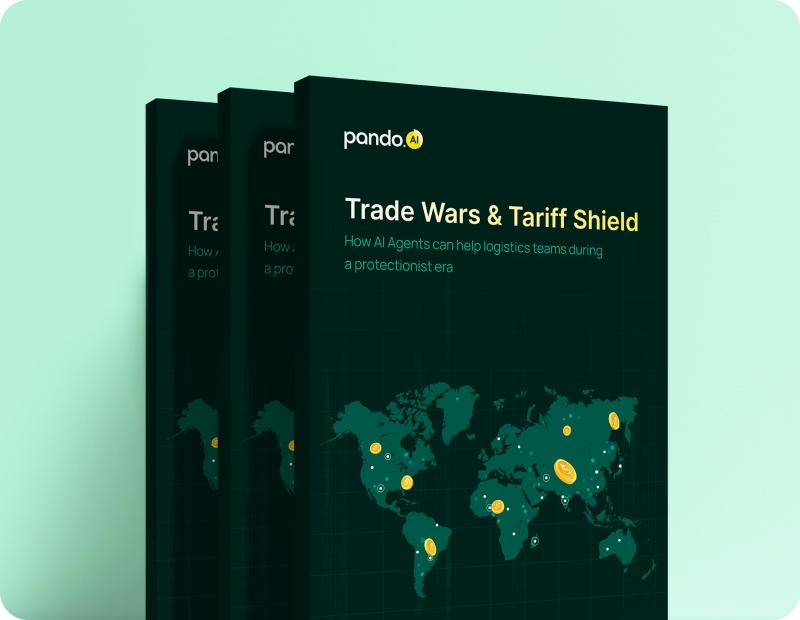-
Products Products
- Industry
- Initiatives
- Resources
- Company
- Book a demo

Before you go: Logistics leaders just dropped the truth on AI
The State of AI in Logistics 2025 is here — no hype, just real conversations and raw insights.
Is your TMS equipped for international shipping? Here's what you're missing.
Why upgrading to an International TMS with specialized focus on multimodal and multileg shipping can save you time, money, and headaches.
Published on April 24, 2024 • 8 mins read
Durga Pratiha

Why upgrading to an International TMS with specialized focus on multimodal and multileg shipping can save you time, money, and headaches.
"Smooth seas do not make skillful sailors." This African proverb perfectly encapsulates the journey of navigating the waters of international shipping. In the vast ocean of global trade, your Transportation Management System (TMS) serves as the compass and map, guiding your cargo from port to port.
But as you navigate through the complexities of international shipping, you realize that prioritizing cost efficiency and embracing sustainability as a necessity, rather than an option, are crucial. Your TMS needs to be evolved to manage different needs beyond domestic logistics that may include collaborating with new partners like freight forwarders or customs brokers, digital document management for regulatory compliance, shipment tracking across multi-modal and multiple legs of movement across multiple currencies, along with the incidence of maritime disruptions, etc.
Top trends shaping international shipping
The era of cumbersome paper trails has been swept away, giving rise to real-time tracking and interconnected platforms. Ships powered by sustainable practices cut through waves, while businesses navigate economic storms and deliver directly to eager customers – all while building a strong supply chain to weather any disruption. Understanding the key trends impacting the industry is crucial to navigate these exciting yet challenging waters. Let's dive into the forces shaping the future of how your goods get from A to B.
-
Supply chain resilience:
As a business operating in the global marketplace, you're likely familiar with the increasing frequency and scale of disruptions that can impact your supply chain. Whether it's a natural disaster, a geopolitical event, or a pandemic, your ability to respond quickly and adapt to these challenges is crucial. Recent events, like the Red Sea Crisis and the Baltimore Bridge Collapse, have highlighted the fragility of international supply chains. A robust TMS must not only anticipate disruptions but also offer agile solutions to navigate through them. Advanced visibility tools offer greater control over your supply chain, enabling you to make informed decisions and respond swiftly to disruptions like identifying an alternate route, air vs ocean freight scenario analysis, etc. Seamless integration with carriers & freight forwarder platforms creates a comprehensive view of your operations and fosters collaboration.
-
Cost-conscious supply chain management:
Have you noticed it's getting tougher to get things where they need to be on time and budget? You're not wrong. The current economic situation, with freight rate volatility, is putting a strain on supply chains everywhere. That means it's costing more to move things around, and that can squeeze your profits. To cope with this, there's a growing demand for tools and strategies to help businesses optimize costs and streamline their operations.
You're probably seeking ways to get more out of every dollar you spend on your supply chain. An International TMS can help you uncover hidden savings, improve your rate forecasting with market rate intelligence, seamless collaboration around document management across ecosystem partners, Intelligent load consolidation and multi-modal routing, etc. These tools work like financial microscopes, allowing you to spot where you can tighten your belt and boost efficiency.
-
Supply chain convergence:
When you're striving for efficiency, complexity can be your biggest obstacle. That's why the industry is moving towards convergence, integrating separate functions like warehousing, transportation, and inventory management into a single, unified system. This streamlined setup gives you a more transparent and responsive supply chain, letting you make quicker decisions and allocate resources more effectively.
This convergence would demand a seamless flow of data across every supply chain function to enable informed and faster decisions. In this context, an International TMS solution integrated with supply chain planning and execution solutions can help you to forecast better – say if you identify a raw material shortage in a specific region, you can trigger a request to alternate suppliers globally so that it doesn’t impact production. A converged supply chain provides greater visibility and control over inventory levels across the entire network. This visibility powered by the International TMS allows for more accurate demand forecasting and inventory optimization, reducing excess inventory, minimizing stockouts, and improving working capital efficiency.
-
Sustainability:
Environmental consciousness is no longer a niche concern – it's a driving force in international shipping. Companies are embracing eco-friendly practices to ensure a healthy planet for future generations. This translates to actions like:
-
- Replacing traditional fossil fuels with biofuels derived from renewable sources can significantly reduce greenhouse gas emissions.
- New ship designs prioritize fuel efficiency, minimizing emissions through innovations in hull shape, engine technology, and wind propulsion systems.
- Ports are increasingly turning to renewable energy sources like solar and wind power to reduce their environmental footprint.
An International TMS can enable you to track your carbon emissions through sustainability reporting aligned to the GLEC framework. Beyond the emission analytics, it can enable you to make decisions around air vs ocean freight, selection of sustainable carriers and fleets or intelligent routing & load consolidation to reduce your carbon footprint.
-
Digitalization:
The rise of digital technologies is likely the most transformative trend you’ll encounter. Leading this change is the impact of AI and machine learning in a TMS. With TMS, your orders can be analyzed and automatically consolidated into optimized shipments. This isn’t science fiction—it’s real technology that accounts for multiple factors, like product mix, customer demands, and even international regulations. This helps you efficiently manage orders across various transportation modes, carriers, and routes. This smart approach boosts efficiency and reduces waste.
But there's more! With 3D load planning software integrated into the TMS, you can ensure that your shipments are packed with precision. It considers stacking rules and loading orientation, maximizing space use, and speeding up handling at ports. Real-time tracking, data-driven insights, and smooth communication are just some of the additional advantages you gain with a TMS in today's digital landscape.
How a multimodal TMS can unlock global possibilities
Juggling the intricacies of international shipping can feel like navigating a labyrinth. From navigating diverse regulations to optimizing costs across multiple legs of a journey, the process is fraught with challenges.
That's where a multimodal international TMS shines, providing a comprehensive solution that addresses the many challenges of global shipping.
-
Global reach and flexibility
A multimodal TMS handles the complexity of international shipping seamlessly. It tracks shipments across multiple legs (ocean voyage, customs clearance, and final delivery) and supports various transportation modes (ships, trucks, planes) in one record across different shipment milestones. Plus, it understands the nuances of different countries, handling things like multiple currencies, date formats, postal codes, customs regulations, document requirements, and even equipment types required for each leg.
-
Smart sourcing and optimization
Picture this: You need to ship containers of mission-critical parts from your factory supplier in China to your assembly units across Europe. Your International TMS takes the guesswork out of the equation. It helps you source quotes, compare rates from various carriers, and even launch automated tenders to get the most competitive offer. Moreover, it optimizes your shipments by consolidating smaller packages into larger ones, reducing overall costs, and managing capacity on specific routes.
-
Streamlined operations and visibility
The International TMS automates tasks like booking, communication, visibility, and exception management. It fosters collaboration by allowing you to share documents and information with all parties involved. Additionally, it provides advanced analytics, helping you identify trends, optimize processes, and make data-driven decisions for future shipments.
-
Incoterms-centric workflows
A multimodal TMS is adept at weaving Incoterms into its workflows, creating a seamless thread that ties together multiple stages, modes, currencies, taxes, ports, and geographic regions. This means fewer surprises at customs and quicker responses to potential delays. Essentially, it’s like having a multilingual, cross-border GPS for your shipments—no matter how complex the journey gets.
-
Cost-saving export and import solution
A multimodal TMS with robust freight procurement capabilities can be a game-changer. By automating the process of sourcing freight through specific RFQ templates, market intelligence, and detailed analysis tools, this kind of TMS helps you uncover hidden cost-saving opportunities. With a dynamic approach to cost management, you can achieve savings of 3-5% without compromising on quality or reliability.
-
Shipping documents digitally managed
An international TMS addresses the paperwork slowdown by embracing digital documentation, transforming the process into a seamless, electronic workflow. This not only streamlines the shipping process but also enhances transparency, giving your customers a better experience.
-
Dynamic rate selection network
With a multimodal TMS, you’re leveraging a vast ecosystem of carriers across multiple transportation modes. This robust network provides a wealth of performance data, rate benchmarking capabilities, and intelligent algorithms for automated carrier selection. This flexibility helps you adapt to market fluctuations, reduce shipping costs, and maintain high service levels.
The power of a multimodal TMS: Your comprehensive toolkit
As you explore the intricacies of international shipping, it's clear that this field is both complex and constantly changing. A well-designed, multimodal TMS gives you a comprehensive toolkit to tackle the many challenges that international shipping presents. It offers real-time tracking, cost efficiency, digital document management, and a network for dynamic rate selection.
In this space, some vendors stand out for their exceptional contributions to the TMS sector, with Gartner recognizing their efforts. These industry leaders have shown they can deliver comprehensive solutions tailored to the demands of international shipping. They prioritize innovation, customer satisfaction, and sustainability.
Choosing a TMS from these leading vendors can position your business to manage the complexities of global logistics effectively. You'll be better equipped to stay on top of industry trends, adapt to changing markets, and maintain high service quality. A powerful TMS becomes more than just software—it turns into a strategic partner in your global shipping journey.
To dive deeper into the details, take a look at Gartner’s research on the international context. This resource offers a thorough analysis of the TMS landscape and highlights the companies that are shaping the future of international shipping.
Subscribe to Pando blog and Crossroads newsletter now!
Stay up to date with the latest logistics, transportation, and supply chain tips and news.
Subscribe Here!












